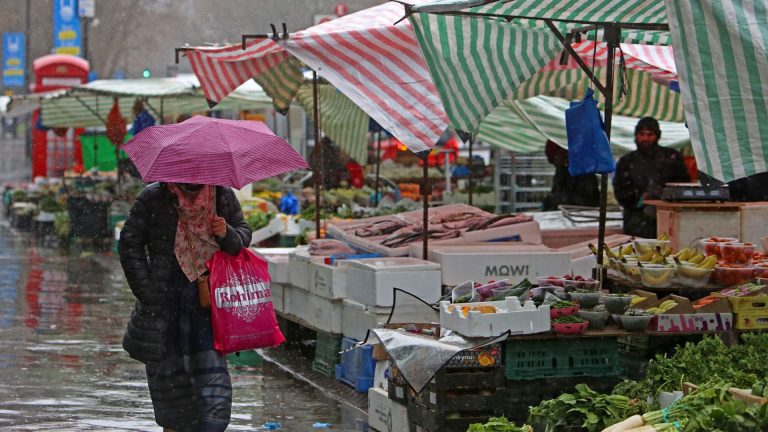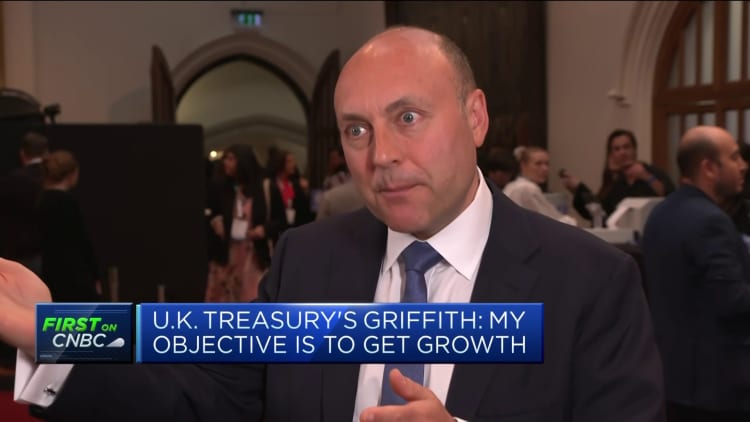
[ad_1]
LONDON – March 31, 2023: A pedestrian shelters from the rain as they walk past fruit and vegetables displayed for sale at a market in stall east London. New data released on Weds, April 19 revealed that food and non-alcoholic beverage prices rose by 19.2% in the year to March 2023, the sharpest annual increase for more than 45 years.
Susannah Ireland/AFP via Getty Images
LONDON — U.K. inflation remained stubbornly in double digits in March, driven largely by soaring food prices, while the country’s cost-of-living crisis shows little sign of abating.
The 10.1% annual headline inflation figure of Wednesday came in above consensus estimates, and the consumer price index rate sits almost a full percentage point higher than the Bank of England’s Monetary Policy Committee projected in its February report.
Food and non-alcoholic beverage prices rose by 19.2% in the 12 months to March, experiencing their sharpest annual incline in more than 45 years, the Office for National Statistics said Wednesday.
As British households continue to contend with high food and energy bills, workers across a range of sectors have launched mass strike action in recent months amid disputes over pay and conditions.
The British government still provides residential energy subsidies, guaranteeing a cap on average household energy bills of £2,500 per year until the end of June, along with targeted support to certain vulnerable homes.
Despite this, Dominic Miles, global co-head of consumer at L.E.K. Consulting, said that the Wednesday figures showed “there is currently no respite from cost of living pressures.”
“Consumers are doing their best to make savings on essentials in order to maintain discretionary spending — this fragile equilibrium is underwritten by the ongoing energy subsidies without which a tipping point might be reached,” he said.
Further monetary policy tightening to come
Though food prices are keeping headline inflation elevated for now, economists expect it to fall sharply in April due the base effects of the spike in energy prices triggered in April 2022 by Russia’s invasion of Ukraine, while energy demand will inevitably fall through the summer.
But upward price pressures are currently proving broader and more stubborn than just these two components.
Core inflation, which excludes volatile food, energy, alcohol and tobacco prices, rose by 6.2% over the 12 months, unchanged from the annual climb of February. This stickiness will be a concern for the Bank of England.
The labor market remains tight, reaffirming that risks to inflation are firmly skewed to the upside.
“Today’s figure shows that the cost-of-living crisis many Britons find themselves in might not be releasing its grip on families as quickly as first expected,” said Tom Hopkins, portfolio manager at BRI Wealth Management.
“The U.K. economy is not out the woods just yet, that said, if economic data continues to come in less negative than expected, it could help stir a revival in business and consumer confidence.”

The widespread strikes and squeezed household incomes were cited as reasons behind the country’s flatlining GDP in February. Meanwhile, persistent high inflation and labor market tightness will likely see the Bank of England continue hiking interest rates, exerting further downward pressure on what is already expected to be the worst-performing major economy in the world over the next two years.
Despite the bleak prognosis, the economic data has, by and large, shown more resilience than many expected late last year, thus far avoiding a technical recession — characterized as two successive quarters of negative growth in real GDP. The independent Office for Budget Responsibility and the central bank no longer forecast a downturn this year.
Given the upside inflation risks, labor market tightness and surprising economic robustness, markets are pricing in that the Bank of England will implement a further 25 basis point hike in interest rates during its May 11 meeting, which would take the main Bank rate to 4.5%.
This consensus was strengthened by an upside surprise in February wage data ahead of Wednesday’s March inflation print, although private sector pay — the MPC’s preferred metric — continued to show signs of slowing momentum.
Upward rate revisions
Several economists took swift action on Wednesday to upgrade their terminal interest rate forecast. Royal Bank of Canada Senior U.K. Economist Cathal Kennedy and Global Macro Strategist Peter Schaffrik upped their outlook to factor in a 25 basis point hike, but expect the Bank to remain on hold for the rest of the year.
Deutsche Bank Senior Economist Sanjay Raja noted that, since the MPC’s March meeting, “all key metrics have outperformed our expectations,” prompting the German lender to revise its forecasts.
“We now expect the MPC to push through two more hikes, taking Bank Rate to the very top end of our terminal rate projection at 4.75% in June,” Raja said in a note Wednesday.
“We expect the MPC to stick to its current data-dependent message in May. And, importantly, we now see risks to our terminal rate forecast skewed to the upside.”

Berenberg also upped its rate forecast from a hold at 4.25% in May to a 25 basis-point hike to 4.5%, with a 30% chance of a further quarter-point hike to 4.75% at the June meeting.
“Looking further out, we continue to expect the BoE to only partly scale back its tightening once inflationary pressures have subsided. In our view, a healthy outlook for long-run demand growth against a host of supply-side headwinds will leave the UK — and the Western world more broadly — more prone to bouts of inflation,” Senior Economist Kallum Pickering said.
The Hamburg-based private bank still projects drops totalling 50 basis points in the fourth quarter of 2023, but the new expectations for the peak means that the Bank rate will end the year at 4% before further cuts in 2024.
“Amid a highly uncertain outlook, we now expect 100bp of cuts instead of 50bp to keep our end-2024 call unchanged at 3.0% — our best guesstimate of the equilibrium bank rate. We maintain our call for no adjustment in the bank rate in 2025,” Pickering added.
[ad_2]
Source link